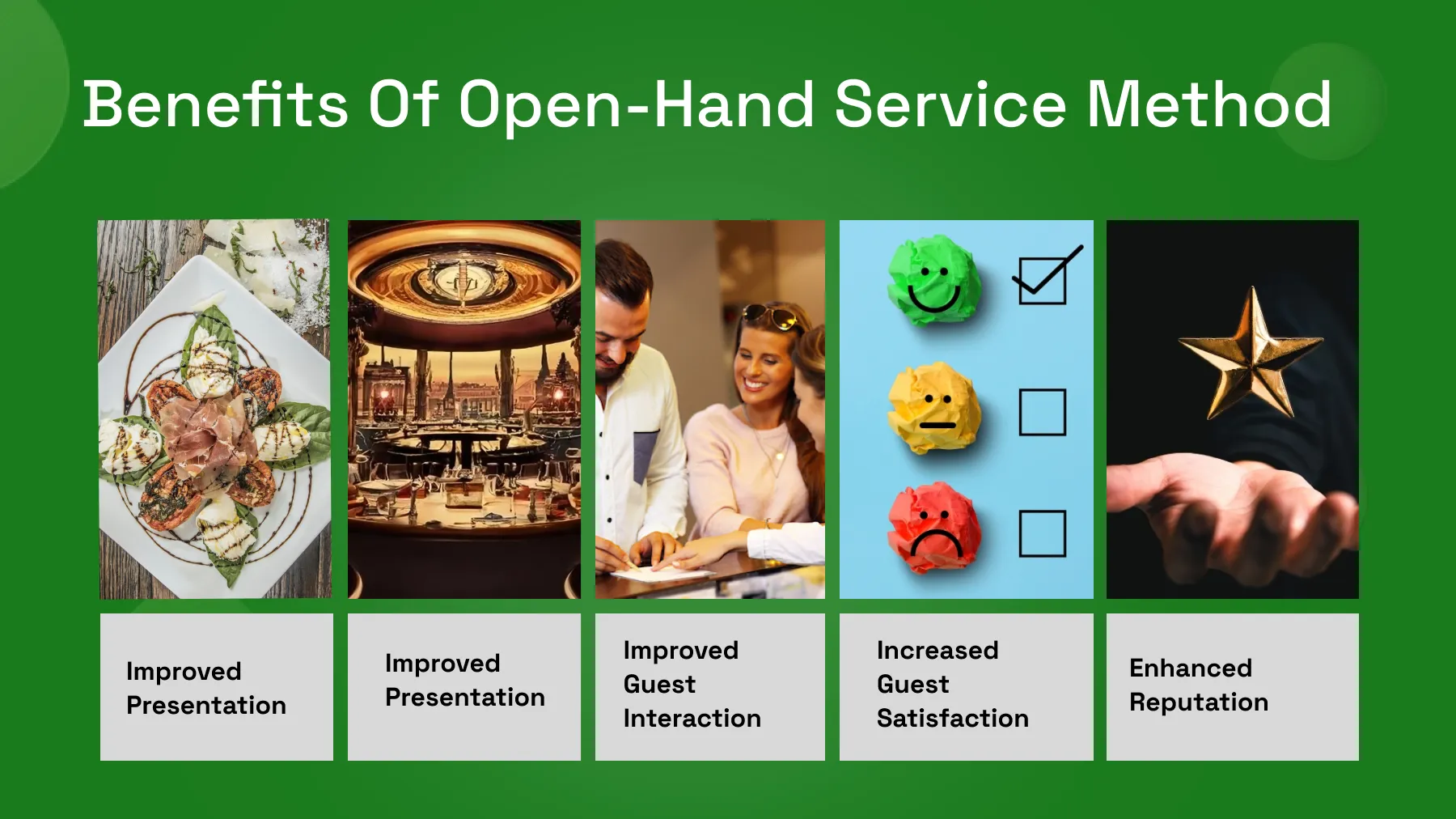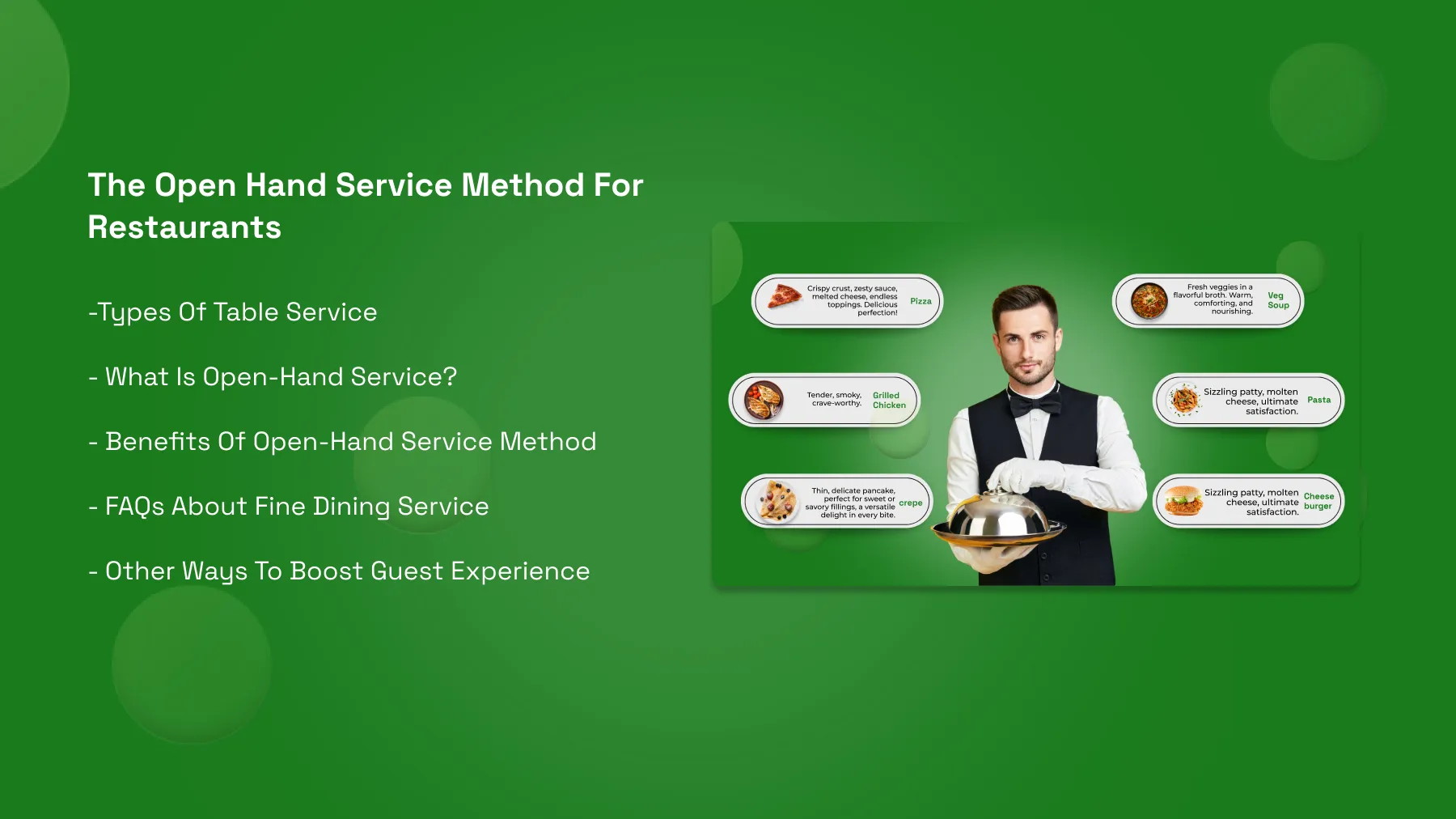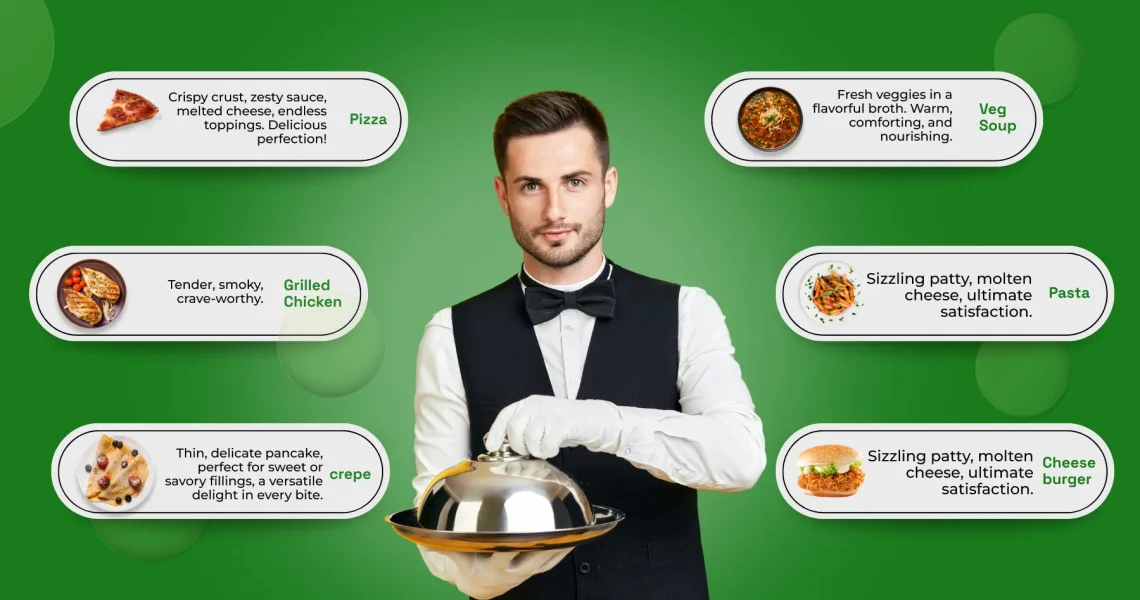The Open Hand Service Method for Restaurants
The power of a memorable single dining experience cannot be underestimated. This is made possible through good service. To achieve success in the dynamic and ever-evolving restaurant industry, providing exceptional service is absolutely essential.

The world of fine dining requires meticulous attention to detail, an elegant atmosphere and formal service. Thus, the open-Hand service method gains significance as an indication of the restaurant’s commitment to delivering outstanding service and customer experience.
This blog is to let you know what the open hand service method means, its key principles such as an etiquette of fine-dining and the remarkable benefits that the restaurant gains when servers follow it.
Proper etiquette while serving elevates the guest experience and enhances the quality of fine dining. A server working in a fine dining establishment will have an eye for details, be observant and intuitive.
Although he remains unobtrusive, he smartly anticipates the needs of guests. This is the key to providing the best service possible.
Types Of Table Service
The type of table service will vary depending on the nature of the event or the meal being served. Fine dining inside a restaurant will be different from consuming a meal at a buffet or a wedding reception where caterers serve food. The common factor in all kinds of services is that they aim to serve patrons quickly and efficiently to create a memorable customer experience. The different types of table service are:
1) American
This is the most common style of table service in which customers choose their options from a menu. The food is then prepared and plated in the kitchen before being brought by servers to the table. The servers should use descriptive adjectives while explaining the items on the menu to the diners and have extensive knowledge of different flavors that the items on the menu possess. Experienced or well-trained servers can successfully predict when to bring items to the table before they are requested.
2) Family-Style
Guests serve themselves from large quantities that are lined up on the dinner table. All the dishes and trays are passed from left to right. Servers will be present only at the beginning and end of the meal only to set up and clean the table. They will not engage in serving food.
3) French
This type of service is not possible without adequate space as food is prepared for guests on a tableside cart called gueridon. Steak, beef wellington or bananas foster are prepared on a hot plate or rechaud.
4) Russian
This service style is the most personalized as food is garnished on a cart beside the guest’s table. Food is prepared completely in the kitchen and carried into the dining space on decorative platters. Due to this, guests must be warned of hot plates or beverages ahead of being seated at the table.
5) Butler
In this service style, food is presented on a tray by the wait staff while guests help themselves. It is also called ‘flying serving’. This type suits better for serving appetizers and hors d’oeuvre at outdoor events or cocktail parties as there is no sit-down dinner in such cases.
6) English
This is found commonly in private dining rooms where a waiter or waitress serves individually from a large platter. They start the service from the host. This style developed from English manor houses starts with the head of the house doing the carving after which the servants begin distributing the portions.
What Is Open-Hand Service?
Working in a formal dining environment involves following several rules and standards related to customer service, sommeliers, posture, ambiance, etc. Having a smiling countenance and being polite are some etiquette practices that everyone knows about. But individuals new to the restaurant or industry might not be aware of the open-hand service method.

Open-Hand service is a fine-dining etiquette practice that is expected to be followed when working in a formal dining environment. This is a guideline and an etiquette principle to be followed to provide patrons with the best meal, service and atmosphere.
It is a method of placing items on a dining table without reaching across the guest at any point. The server must use the right arm while serving from the guest’s right side and left arm to serve from the guest’s left side.

Not pointing the elbow towards the guest is an important aspect of open hand service. This service technique is practiced for maintaining proper etiquette and avoiding any potential discomfort or intrusion for the diner.
Benefits Of Open-Hand Service Method
The Open-Hand method is a special technique that is followed by waiters of fine dining restaurants to serve and deliver food with a distinct approach. The open hand service method offers several advantages. Some of them are listed below:

1) Improved Presentation
This method enhances the overall presentation resulting in a memorable dining experience. When servers use the appropriate arm for each side, their style of serving and movements appear coordinated and graceful. The visual appeal of the service gets enhanced when the server avoids crossed arms in the presence of the guest at the table. This creates a clean and organized atmosphere. When attention is given to even such minute details, the dining environment gets elegant and refined. The guests are sure to leave with a positive impression.
2) Enhanced Table Navigation
The open hand service method enables easy and efficient navigation of the servers across the dining area. When servers are trained well to use their right arm to serve guests on the right side and their left arm to serve the ones on the left side, they can move elegantly around the table without causing obstructions or disruptions to the diner. This type of movement ensures smooth and uninterrupted service flow and minimizes guest inconvenience.
3) Improved Guest Interaction
When the open hand service method is followed, servers maintain an appropriate distance from guests and yet provide exceptional service. This method prioritizes guest interactions, creates a dignified and memorable dining environment enabling guests to indulge in the food completely and continue to interact amongst themselves without getting a feeling of being crowded or overwhelmed. This method increases the comfort zone of the diners resulting in a dining experience that is sure to receive positive reviews and create loyal customers.
4) Increased Guest Satisfaction
When open hand service method is implemented, it leads to great customer satisfaction. The diligent attention to minute details and professionalism exhibited by the servers who follow this principle leave a favorable impression on the guests. The guests feel that they have been treated well, are valued and well attended to. This satisfaction leads to repeat visits, positive word-of-mouth and good reviews on social media leading to the development of a loyal customer base.
5) Enhanced Reputation
Implementing the open hand service method impacts the reputation of the restaurant in a significant manner. Restaurants that give importance to proper etiquette and guest comfort are regarded by customers as sophisticated and professional. When this method is followed consistently, restaurants can take pride in marketing themselves as establishments offering outstanding service. This commitment to customer service helps get the attention of discerning diners who, in turn, assist in building a positive reputation in the industry. This reputation is sure to attract several new customers and reinforce the restaurant’s brand as a reputable and esteemed dining destination.
FAQs About Fine Dining Service
Fine dining service rules are derived from traditions that have been practiced for several years. However, every restaurant may have its own interpretation for service. The following section answers frequently asked questions that arise due to confusion in topics related to fine dining.
Q. Which side should the server serve from?
Ans: As far as American service is concerned; pre-plated courses are served from the left but cleared from the right. This is primarily because glasses are located to the right of the guest. Always keep in mind not to cross your arms in front of a guest as this is the most important fine dining rule.
Q. What is open hand service?
Ans: This service method emphasizes the practice of placing items on the table without ever reaching across a guest as it would cause discomfort to them. To follow the open hand service method, you must always use the right arm to serve the guest from the right and the left arm to serve them from the left. This is because, when you use the opposite arm, your elbow tends to point towards the guest causing inconvenience.
Q. Should ladies be served first?
Ans: It is a traditional practice to serve ladies first during every step of the dining service. But, in recent times, this school of thought is being seen as outdated. So, follow the guidelines of your restaurant or the rules drafted by your front-of-house manager. In case your restaurant follows the longstanding practice of serving ladies first, begin with the oldest lady present at the table and start moving clockwise around the table. You will need to go another lap to serve the gentlemen. However, if this is not your restaurant’s protocol, simply use the seat numbers as your guide.
Q. Should servers be clean shaven?
Ans: Fine dining establishments require servers to be clean shaven. But since several older traditions and rules in serving have been relaxed over time, facial hair might be acceptable in some fine dining restaurants. However, it needs to be neatly trimmed and give a well-groomed look.
Other Ways To Boost Guest Experience
There are many ways to enhance guest experience in a fine dining restaurant. Here are a few ideas that can streamline venue operations and give high priority to guest satisfaction.
1) Online Table Reservation – Provide easy options for customers on the restaurant website, mobile app, Google and social media platforms to make table reservations.
2) Waitlist Management – With digital data about customers, you can track their preferences, deliver personalized experiences and manage the waitlist effectively.
3) Pre-payments – Reservation deposits reduce the occurrence of no-shows and ensure that tables are filled. This helps optimize the restaurant’s revenue.
4) Hospitality CRM – A centralized Customer Relationship Management (CRM) allows the restaurant to collect, store and retrieve all guest data in one user-friendly interface. This helps in marketing activities and provides a service that creates customer loyalty.
This blog would have helped you understand the nuances of open hand service method and the benefits that it brings to restaurants. If you are looking for more assistance in restaurant website building and digital marketing, get in touch.
KEY TAKEAWAYS!

